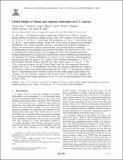| dc.contributor.author | Xiao, Yaping | |
| dc.contributor.author | Logan, Jennifer A. | |
| dc.contributor.author | Jacob, Daniel J. | |
| dc.contributor.author | Hudman, Rynda C. | |
| dc.contributor.author | Yantosca, Robert M. | |
| dc.contributor.author | Blake, Donald R. | |
| dc.date.accessioned | 2010-01-21T15:07:56Z | |
| dc.date.issued | 2008 | |
| dc.identifier.citation | Xiao, Yaping, Jennifer A. Logan, Daniel J. Jacob, Rynda C. Hudman, Robert Yantosca, and Donald R. Blake. 2008. The global budget of ethane and regional constraints on U.S. sources. Journal of Geophysical Research 113(D21306): 1-13. | en_US |
| dc.identifier.issn | 0148-0227 | en_US |
| dc.identifier.uri | http://nrs.harvard.edu/urn-3:HUL.InstRepos:3554393 | |
| dc.description.abstract | We use a 3-D chemical transport model (the GEOS-Chem CTM) to evaluate a global emission inventory for ethane (C2H6), with a best estimate for the global source of 13 Tg yr−1, 8.0 Tg yr−1 from fossil fuel production, 2.6 Tg yr−1 from biofuel, and 2.4 Tg yr−1 from biomass burning. About 80% of the source is emitted in the Northern Hemisphere. The model generally provides a reasonable and unbiased simulation of surface air observations, column measurements, and aircraft profiles worldwide, including patterns of geographical and seasonal variability. The main bias is a 20%–30% overestimate at European surface sites. Propagation of the C2H6 seasonal signal from northern midlatitudes to the equatorial western Pacific and the southern tropics demonstrates the dominance of northern midlatitudes as a source of C2H6 worldwide. Interhemispheric transport provides the largest C2H6 source to the Southern Hemisphere (1.7 Tg yr−1), and southern biomass burning provides the other major source (1.0 Tg yr−1). The C2H6 emission inventory for the United States from the Environmental Protection Agency (0.6 Tg yr−1) is considerably lower than our estimate constrained by extensive aircraft observations in the continental boundary layer (2.4 Tg yr−1). This appears to reflect a factor 7 underestimate in the fossil fuel source over the south-central United States. Our estimate of C2H6 emissions, together with observed ratios of CH4:C2H6, suggests that CH4 emissions from energy production in the U.S. may be underestimated by as much as 50%–100%. | en_US |
| dc.description.sponsorship | Earth and Planetary Sciences | en_US |
| dc.description.sponsorship | Engineering and Applied Sciences | en_US |
| dc.language.iso | en_US | en_US |
| dc.publisher | American Geophysical Union | en_US |
| dc.relation.isversionof | doi:10.1029/2007JD009415 | en_US |
| dc.relation.hasversion | http://acmg.seas.harvard.edu/recentpapers.html#P2008 | en_US |
| dash.license | LAA | |
| dc.title | Global Budget of Ethane and Regional Constraints on U.S. Sources | en_US |
| dc.type | Journal Article | en_US |
| dc.description.version | Version of Record | en_US |
| dc.relation.journal | Journal of Geophysical Research -All Series- | en_US |
| dash.depositing.author | Jacob, Daniel J. | |
| dc.date.available | 2010-01-21T15:07:56Z | |
| dc.identifier.doi | 10.1029/2007JD009415 | * |
| dash.contributor.affiliated | Yantosca, Robert | |
| dash.contributor.affiliated | Logan, Jennifer | |
| dash.contributor.affiliated | Jacob, Daniel | |


